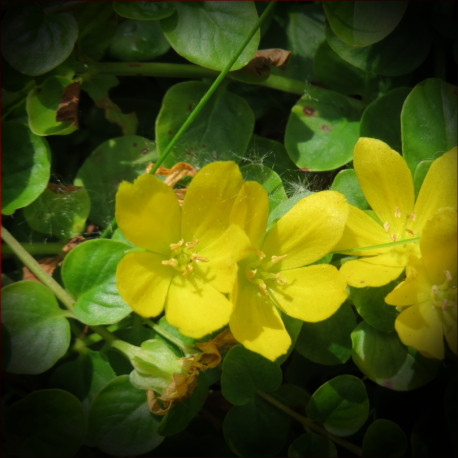More info
Datasheet
| Aquarium Compatible | yes |
| Plant Outdoor | yes |
| Plant Emersed Growth | yes |
| Plant Growth | medium |
| Temperature Tolerance | 4°C / 39.20°F - 30°C / 86.00°F |
| Temperature | 18°C / 64.40°F - 20°C / 68.00°F |
| Light | medium-high |
| Nitrate (NO3-) | 10-50mg/lmg/l |
| Phosphate (PO43-) | 0.1-3mg/lmg/l |
| Potassium (K+) | 5-30mg/lmg/l |
| Iron (Fe) | 0.01-0.5mg/lmg/l |
General Description
Lysimachia nummularia, commonly known as moneywort or creeping Jenny, is a native European plant that has also been introduced into North America. This creeping plant is widespread in Germany, thriving in moist meadows, riverbanks, lakeshores, pond edges, alluvial forests, and forest mires. It is a popular ornamental plant in gardens, ideal for planting along garden pond edges, as ground cover in moderately moist areas, and even as a hanging plant. In early summer, it produces abundant golden yellow flowers. This versatile plant can also be cultivated submersed and has been utilized as an aquarium plant since the early days of aquaristics.
Aquarium Suitability
Lysimachia nummularia is often available commercially and is suitable for aquariums, presenting easy care requirements (see table). It is an excellent choice for aquarists due to its adaptability and low maintenance nature.
Demands and Hardiness
This plant has medium growth and is suitable for both emersed and submerged cultivation. It can be used in the background, midground, Dutch style street aquascapes, as well as in the foreground or as a group. With its ability to tolerate colder temperatures, L. nummularia is a hardy plant that can thrive in various aquatic setups (see table).
Aquascaping & Usage
Lysimachia nummularia is versatile in aquascaping, making it suitable for various aquarium layouts. Its creeping nature allows for dynamic foreground displays, while its bright yellow flowers add a pop of color to the tank. It can be used to create intricate designs or as a lush filler in planted tanks.
Propagation
Propagation of Lysimachia nummularia is easily achieved through cuttings, making it a convenient choice for aquarium enthusiasts looking to expand their plant collection.
Habitat and Distribution
This species is native to a large part of Europe, with North America being an introduced range. It thrives in diverse habitats, such as moist meadows, riverbanks, lakeshores, and forest mires, showcasing its adaptability to varying environmental conditions.

